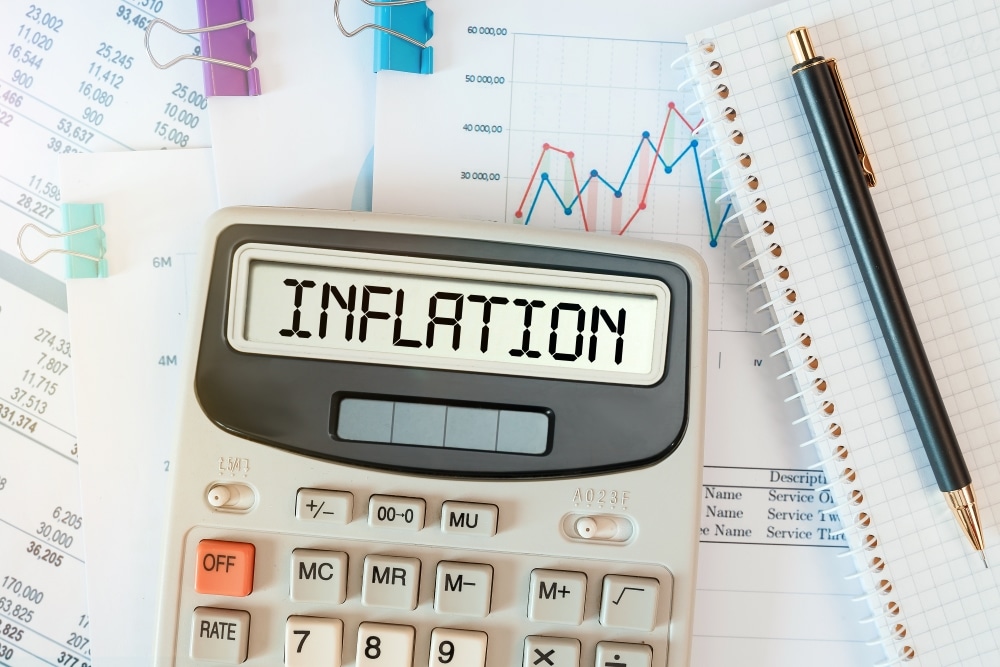Inflation, the general increase in the price of goods and services, has multifaceted effects on retirees. While localized price fluctuations occur due to changes in supply and demand, true inflation is marked by an across-the-board price surge. Retirees, in particular, bear the brunt of inflation, with rising living costs, stagnant incomes, and diminishing purchasing power.
Since existing savings and investments fund a large part of retirement for many individuals, it’s especially important to learn how to account for inflation in retirement planning to address this drop in purchasing power. With the right strategies, you can still save money, overcome inflation, and enjoy a comfortable and secure retirement.
Let’s take a closer look at what inflation is and how it affects retirees. Then, we’ll provide general principles explaining how to plan for inflation in retirement.
Why Inflation Happens And How It Impacts Retirees
Inflation is a general rise in the price of goods and services in an economy. The key is the word “general.” If the price of cars increases, but the price of motorcycles does not, then there’s no inflation. In our economy, we constantly see the prices of some products or services increase while the prices of other products and services decrease. These price changes reflect changes in the relative demand and supply of each item.
For example, during the winter, the demand for coats increases while the demand for swimsuits decreases. Coat costs go up, while swimsuits go on sale. This scenario is not inflation. Every major holiday, every season of the year, and every region of the country experiences predictable changes in demand and supply. None of these price changes are inflation.
When we see the “general” level of prices increasing across the board, then we are experiencing inflation.
As the Nobel prize-winning economist Milton Freidman demonstrated, “Inflation is always and everywhere a monetary phenomenon.”
What he meant is that inflation is created when the amount of money is increased excessively. The Federal Reserve Bank controls the supply of money in this country, and when they put too much money into the economy, inflation is the inevitable result.
How Do We Measure Inflation
There are several measures of inflation, depending on the level of the economy you want to measure. The most common measure – and the one that impacts most people – is the Consumer Price Index. The U.S. Bureau of Labor Statistics creates a “basket” of various goods and services consumed by households. To calculate the inflation rate, they compare the value of this price index from one period to another. You will often see inflation rates quoted as “month-over-month” or “year-to-year.” The Personal Consumption Expenditures (PCE) price index is another measure of consumer inflation.
Going back a level – to the prices that manufacturers charge – the Bureau of Labor Statistics tracks the Producer Price Index. Here again, they have created a basket of items that producers sell, and they track the price change over time from the purchaser’s perspective.
We usually see producer prices increase slightly ahead of consumer prices. So, the Producer Price Index is a leading indicator of the Consumer Price Index.
How Does Inflation Impact the General Economy
Inflation distorts the flow of information necessary for people to make economic decisions, reduces current profits, and diminishes the value of future profits, impacting the overall economy. Managers and consumers both make purchase decisions based on what they expect costs to be.
You might buy a car because you believe you can afford it at a certain price. If you go to the dealership and find the cost has risen, you might decide not to purchase it. This effect is magnified for company managers when considering long-term projects like building a factory or launching a new product. They make projections of costs and profits based on the price information they have at that time.
Inflation changes those prices, and because the prices of different components change at different rates, the information is distorted. It becomes more difficult for managers to figure out whether they will make a profit on a new product or factory, so they postpone the decision.
Even for existing products, inflation impacts profitability. Manufacturers have to buy raw materials before they can make and sell a product. As the costs of materials go up, the profit drops until the company can adjust its prices to its customers. Inflation squeezes profit margins.
All together, inflation usually has a depressing impact on the overall economy. Conventional wisdom holds that economies grow with inflation. However, inflation does not increase the size of the economy. It has just increased the prices of all the stuff in the economy. As inflation starts distorting more and more of the economy, we see the real level of the economy decrease.
How Does Inflation Affect Retirees
Consumers, in general, are impacted by inflation on two sides. First, as discussed above, their cost of living is increasing. Second, though, they often find that their wages don’t keep up when inflation first starts. Most workers work under a set wage scale their employer offered or their union negotiated. Those wages don’t increase automatically with inflation. When inflation first hits, wages remain where they were while living costs increase. Eventually, companies renew employment or labor contracts, making inflation adjustments. However, in the short term, consumers experience a squeeze.
Retirees are hit on three sides.
Their Cost of Living Increases
Retirees, like everyone else, see the costs of the goods and services they use increase across the board with inflation.
Their Fixed Income Lags Inflation (or don’t change at all)
Many retirees receive a significant portion of their retirement income as “fixed” or “partially fixed” income. Pensions and retirement annuity contracts are notorious for paying a fixed amount for life. As inflation increases the cost of living, these income sources do not increase.
Other parts of retirement income slowly increase and experience a significant delay before any adjustment. In the past, Social Security has fallen behind inflation. Today, Social Security benefits are adjusted for inflation, but this only happens periodically. The cost of living goes up daily, and Social Security is adjusted annually.
Retirement Savings Lose Value
Retirement savings often lose value during inflation, impacting a retiree’s long-term future even after inflation is eventually tamed.
Most bank savings accounts or CDs fail to keep up with inflation, and many retirement investment accounts are not structured properly for inflation. Does this mean savings, CDs, or investment accounts don’t earn money during inflation?
The answer is no; they usually earn something, but often, it is not enough to maintain purchasing power. Purchasing power is a measure of what your money can buy. As prices increase with inflation, it takes more money to be the same thing. For example, the average price for a pound of coffee in the U.S. in 2025 was around $7.00. In 2015, it was $4.70; in 2005, it was $3.20. In just ten years, it has increased by 47%, and over 20 years, it has increased by 119%.
Purchasing power means that if your savings and investment accounts don’t grow, they will buy fewer things. In the example above, the $4.70 from 2015 would NOT buy a full pound of coffee today. Your ability to purchase the same amount (purchasing power) has decreased.
Retirees are in a particularly vulnerable place. Their living costs are increasing, so they need more money to afford the same living standard, but their income is stagnant or lagging, so they need to dip into savings for more money just to buy the same stuff. Sadly, in too many instances, retirees also see that their savings and investment accounts have not increased to keep up. In many cases, they have decreased because of poor planning.
Many readers will remember the “great inflation.” This was the period from 1965 to 1982 when U.S. inflation averaged 6.81% per year over 17 years. That represented a 206.3% cumulative increase in prices. It hurt everyone; it was devastating to retirees.
How to Account for Inflation in Retirement Planning
The good news is that inflation does not have to devastate you. Everyone’s situation is unique, but there are some general principles you can follow to plan for inflation in retirement:
Revisit your budget to identify and eliminate any frivolous expenses. We all tend to overspend a bit. During normal times, this isn’t as bad as it is during inflation. Every dollar you can avoid spending on silly stuff is one dollar you can spend on important items without dipping more into savings. Effective budgeting is key.
Build an emergency fund to provide ready access to cash without taking more from investment accounts. Use a checking account for day-to-day expected expenses, use a savings account to accommodate the irregular expenses we all have from time to time, but most importantly, build the emergency fund so you have a bigger margin of safety.
Restructure retirement income where possible to reduce the amount of fixed or partially-fixed income. The more control you have over your earnings and income, the more successful your retirement will be.
Implement an investment structure that will survive the early stages of inflation and thrive over the long term. Whatever stage you’re in (retired or not yet retired), this is one of the most important steps you can take.
If you’re not yet retired, increase the amount you’re saving and investing. Ultimately (as discussed below), a well-structured investment portfolio will overcome inflation over the long term; every dollar you can put to work today will provide you with a multitude in the future.
In 5 years…
$100 will grow to $116 at a 3% investment return
$100 will grow to $133 at a 6% investment return
$100 will grow to $146 at an 8% investment return
$100 will grow to $161 at a 10% investment return
Work With A Qualified Retirement Planner to Plan for Inflation
Again, everyone’s situation is unique, and everyone’s plan needs to be unique, reflecting their current situation, their retirement needs, the impact inflation will have on those needs, and what strategies need to be implemented to ensure a successful retirement even when facing elevated inflation levels, as we are today.
Here are some things to consider when deciding how to plan for inflation in retirement:
- Your specific goals – you can’t get there if you don’t know where you’re going
- Maximize the time you have left – whether you’re still planning for retirement or already retired, procrastination can be deadly. Every year you don’t have a successful plan in place is a year you fall behind.
- Accurately assess how many years retirement will last – you will most likely live longer than you imagine, and if you aren’t realistic about that, you increase the risk of running out of money.
- Identify major unexpected retirement costs – too many people fail to consider what healthcare or long-term care costs might be.
- Develop the right investment strategy for inflation – your investment plan needs to provide for your expected cashflow needs, anticipate your unexpected cashflow needs, protect the portfolio against inevitable interest rate hikes, and actually grow the portfolio to maintain purchasing power.
- Take full advantage of Social Security – Social Security may lag inflation, but you should do everything you can to maximize the benefit you do receive
Don’t Go It Alone
Inflation is an ugly beast. It ravishes those who are unprepared. Planning for inflation is no longer an intellectual exercise; it’s not a theory about what might happen in the future. It’s here now and will remain with us for a very long time. You have to get all the key points right; you can’t get just one of the above principles right; you have to get them all right. Seek professional help when deciding how to account for inflation in retirement planning. However, it’s critical that you also rely on objective help. Now is not the time to trust someone selling financial products. They are salespeople; they are not advisors.
Quality matters. Bad advice will produce bad results. And prejudiced advice is bad advice. Financial product salespeople peddling insurance, annuities, “guaranteed income streams,” etc., have tremendous conflicts of interest. Their best interest is not your best interest.
We here at First Financial Consulting offer 100% objective retirement and investment advice. We meet the fiduciary standard, the highest standard of dedication to the client. We also have a 45+ year track record of helping clients through all seasons of life and all stages of inflation, recession, and economic growth. If you’d like to begin a conversation to conquer inflation instead of suffering from it, please use the button below to schedule a complimentary introductory appointment.
Greg Welborn is a Principal at First Financial Consulting. He works with individuals and privately-owned businesses on financial planning issues including investment, retirement, and tax planning, among others.
Greg Welborn is a Principal at First Financial Consulting. He works with individuals and privately-owned businesses on financial planning issues including investment, retirement, and tax planning, among others.


